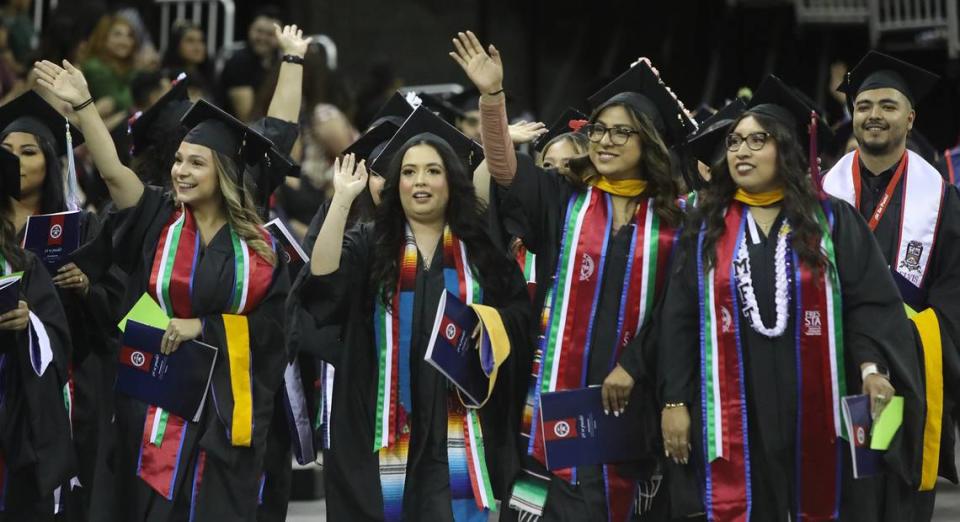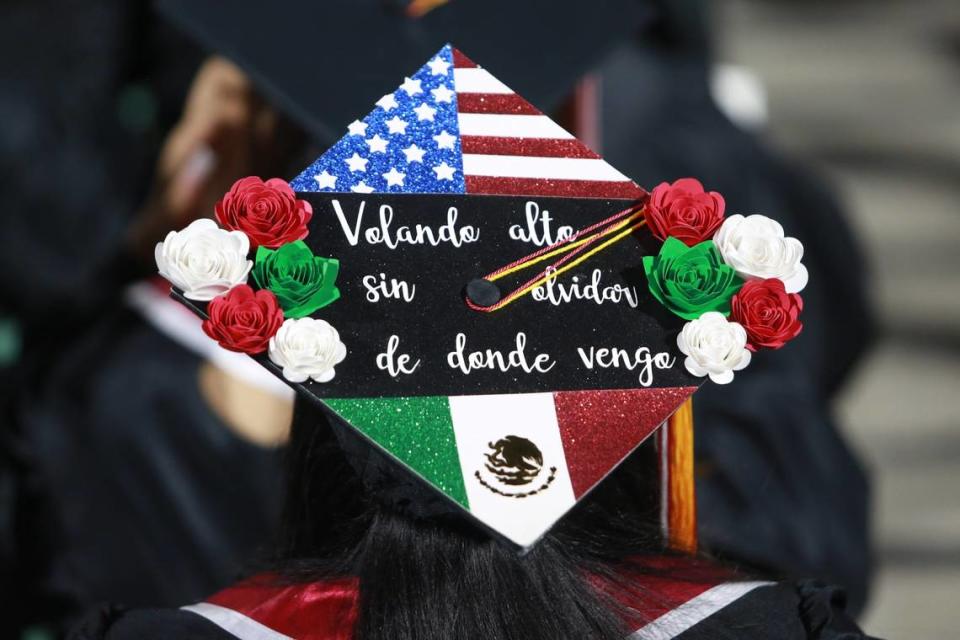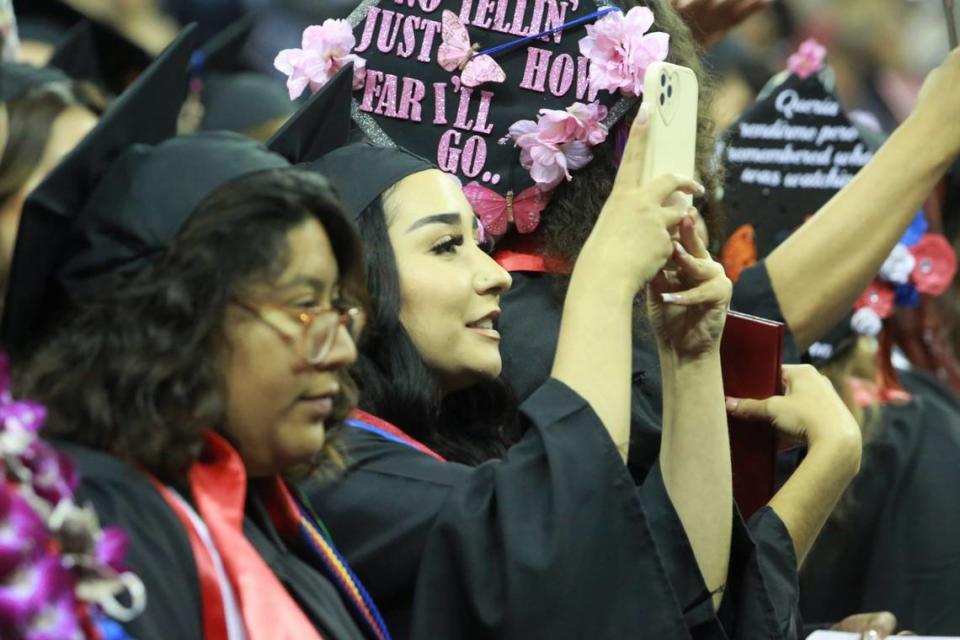California Latinos face historic college enrollment declines. A look at the Central Valley
From Kern to San Joaquin County, an estimated 2.4 million Latinos live in the central San Joaquin Valley, where they make up an estimated 54.8% of the residents, according to July 2022 census data.
It’s only expected to grow. The Central Valley is expected to add about 5 million people by 2060, according to the California Department of Finance.
The growing population raises questions about the future of the region’s educational and economic outcomes.
In the central San Joaquin Valley, four-year college graduation rates for adults over 25 have lagged behind other major metropolitan areas such as Los Angeles, Orange and San Francisco counties for years. Graduation rates for counties in the Valley range from 14% to 22%, comparatively larger regions like Los Angeles and San Francisco are 34% to 60%.

Nationwide, a 2023 Lumina Foundation-Gallup poll shows that 50% of Latino college students are considering dropping out of college altogether, while other data shows that the gap between Latino and White college completion is growing. The stark numbers can be largely attributed to the coronavirus pandemic, with the latest data showing the CSU system has experienced “unprecedented” enrollment declines.
This declining college enrollment could have big implications for the central San Joaquin Valley, where Latinos make up half of all graduates from the region’s four public California State University campuses.
But Benjamín Durán, executive director of the Central Valley Higher Education Consortium — a nonprofit made up of 28 Valley colleges and universities working to increase higher education attainment rates — is hopeful. He noted the growing collaborations between local community colleges, state and private universities that are creating education pathways that meet the specific needs of the Central Valley’s rural, largely Latino communities.

Across the Valley, education leaders are working on solutions to boost college attainment and completion, such as: offering more dual enrollment at rural high schools, four-year degrees at community colleges, direct admit programs for qualifying high school graduates and education pathways for the formerly incarcerated.
“That just didn’t happen 20 years ago,” Durán said.
Plus, he said Central Valley higher education institutions are bouncing back from their post-pandemic drops “faster, frankly, than the rest of the state.”
Join La Abeja’s reporting team — journalists from The Fresno, Sacramento, Modesto Bees and Vida en el Valle — at 6 p.m. Nov. 8 for a virtual, hour-long panel conversation with state and Central Valley education leaders to understand the barriers and opportunities to Latino student success.
A look at Central Valley institutions
Most Central Valley four-year university students attend CSU campuses, according to data from the CVHEC.
Statewide, the CSU system grants about half of all bachelor’s degrees in California — where nearly half of the student body is made up of Latinos. As of fall 2022, the CSU system had a Hispanic student enrollment rate of 47% for the Fall 2022 semester.
The Central Valley is home to four California State University campuses between a 285-mile stretch from Kern to Sacramento counties including Bakersfield, Fresno, Stanislaus and Sacramento (there is also a University of California campus in Merced, as well as UC Davis near Sacramento).

Local universities, like Fresno and Stanislaus, have made “commendable strides in closing equity gaps” in graduation rates, according to a report by The Campaign for College Opportunity.
But the report says gaps for Black, Latino and American Indian students remain “unacceptably high” and these challenges persist system-wide.
Bakersfield
CSU Bakersfield’s Institutional Research, Planning, and Assessment office reports as of August 2023:
Enrollment: 9,261 students in 2022, and 68% identified as Hispanic.
Retention: 79.9% of students returned after one year in 2022.
Graduation: 27.5% in four years in 2019, per university data.
Fresno
Fresno State’s Office of Institutional Effectiveness reports:
Enrollment: 23,832 students in the Fall 2023 semester, and 58.5% identified as Hispanic, according to university information.
Retention: 77.8% retention rate from first-year to second-year return full-time students, 78% of which identified as Hispanic.
Graduation: 30% for degree completion within four years for full-time students who enrolled in higher education for the first time in 2019, per university data.
Sacramento
Sacramento State’s Institutional Research, Effectiveness, & Planning department reports:
Enrollment: 30,193 total students as of Fall 2023, from which 36% identified as Hispanic.
Retention: 80.3% of all first-time freshman students were retained in fall of 2022, compared to 78.3% for Hispanic freshman.
Graduation: 27.8% of four-year students graduated in 2019, compared to 28.1% for Hispanic freshman.
Stanislaus
Stanislaus State’s office of Institutional Effectiveness & Analytics reports:
Enrollment: 10,155 total students in the Fall 2022 semester, per university data. Of them all 6,233 (or 61%) identified as Hispanic.
Retention: 80.7% overall and 81.1% for first-year Hispanic students first-year students in Fall 2021.
Graduation: 46% of four-year students graduated in 2018, per the latest dashboard data.

